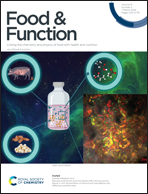Lactic acid bacteria modulate the gastrointestinal digestive behavior of soy glycinin and correlation with its immunoreactivity: a peptidomic study
Abstract
Lactic acid bacterial fermentation helps reduce the immunoreactivity of soy protein. Nevertheless, the effect of lactic acid bacterial fermentation on a particular soy allergen and the consequent dynamic change of epitopes during gastrointestinal digestion are unclear. In this study, soy glycinin was isolated and an in vitro dynamic gastrointestinal model was established to investigate the dynamic change in the immunoreactivity and peptide profile of unfermented (UG) and fermented glycinin (FG) digestates. The results demonstrated that the FG intestinal digestate had a lower antigenicity (0.08%–0.12%) and IgE-binding capacity (1.49%–3.61%) towards glycinin at the early (I-5) and middle (I-30) stages of gastrointestinal digestion, especially those prepared at 2% (w/v) protein concentration. Peptidomic analysis showed that the glycinin subunits G1 and G2 were the preferred ones to release the most abundant peptides, whereas G2, G4, and G5 had an elevated epitope-cleavage rate in FG at stages I-5 and I-30. Three-dimensional modeling revealed that fermentation-induced differential degradation epitopes in gastrointestinal digestion were predominantly located in the α-helix and β-sheet structures. They were closely correlated with the reduced immunoreactivity of soy glycinin.



 Please wait while we load your content...
Please wait while we load your content...